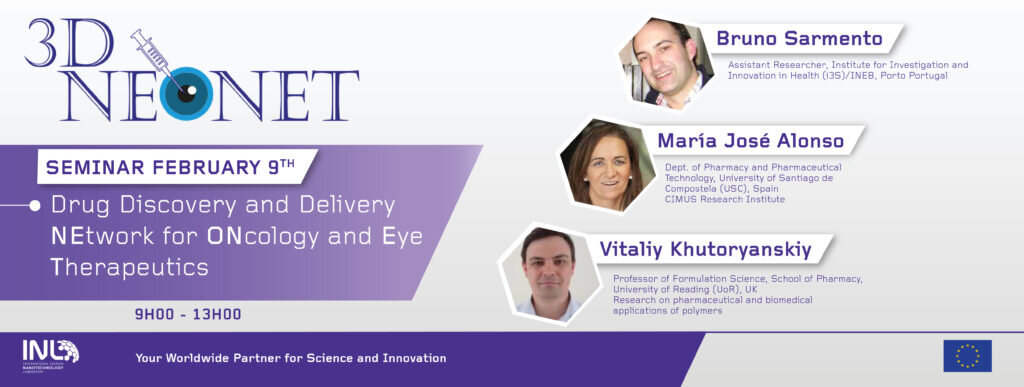
Drug Discovery and Delivery Network for Oncology and Eye Therapeutics (3DNeoNet Seminar)
February 5, 2018
Friday 9th February, at the INL Auditorium
This seminar is an event organized in the framework of the Annual Meeting of the project 3DNeoNet, led by the University College of Dublin (UCD), and in which INL is part of the Consortium. The overall goal of 3DNeoNet is the improvement of available treatments for cancer and ocular disease by enhancing drug discovery-development and delivery to targeted tissues, through advanced international co-operation between academic and non-academic partners. The interdisciplinary expertise provided by 18 partners in 7 countries encompasses among others: drug screens, ADME, toxicology, preclinical models, nanotechnology, biomaterials and clinical trials.
There will be three internationally recognized speakers with outstanding contributions in the fields of drug delivery, cancer therapy, and polymer chemistry: Prof. María José Alonso (University of Santiago de Compostela, USC), Prof. Vitaliy Khutoryanskiy (University of Reading, UoR), and Bruno Sarmento (Institute for Investigation and Innovation in Health (i3S)/INEB).
After their talks, there will be a Round Table, entitled: Challenges of the start-ups in the health/ pharma industry. From the idea to the market, chaired by Breandan Kennedy (UCD), Head of the 3DNeoNet Industry-Academia consortium, and Beatriz de la Parra, founder of the company ECM Ingeniería Ambiental S.L.(Spain).
Advanced registration is required. Please sign up until Wednesday 7th February 2018 in the link below:
Please also be welcome to extent this invitation to those that you think would be interested in this event.
About the speakers:
María José Alonso
Professor of the Department of Pharmacy and Pharmaceutical Technology, CIMUS Research Institute, University of Santiago de Compostela (USC), Spain
María José Alonso’s lab has pioneered numerous discoveries in the field of Nanopharmaceutical Technology and Nanomedicine. She has coordinated several research consortia financed by the WHO, the Gates Foundation and the European Commission. She is the author of over 250 scientific contributions with more than 13,000 cites (H factor 65) and the inventor of 20 patent families. She has been among the TOP TEN in Pharmacology (Times Higher Education international ranking, 2010). She is currently President-elect of the Controlled Release Society. She is a fellow of the American Institute for Medical and Biological Engineering (AIMBE), a member of three Academies in Spain and a member of the US National Academy of Medicine (NAM).
Vitaliy Khutoryanskiy
Professor of Formulation Science, School of Pharmacy, University of Reading (UoR), UK
Research on pharmaceutical and biomedical applications of polymers. Specialties: Polymers for pharmaceutical application, Mucoadhesive drug delivery systems, Water-soluble polymers, amphiphilic polymers and polymeric complexes, Hydrogels, biomaterials & polymeric blends, Polymer colloids, PEGylated nanoparticles, Stimuli-responsive polymers, Polysaccharides (chitosan, cellulose ethers, alginates), Organosilica nanomaterials, Cationic polymers for gene delivery, Radiation chemistry of polymers, Ocular drug delivery. He is the author of more than 150 scientific contributions with more than 3,100 cites (H factor of 31).
Bruno Sarmento
Assistant Researcher, Institute for Investigation and Innovation in Health (i3S)/INEB, Porto, Portugal
His current research is focused on the development of functionalized nanomedicines and their application in the pharmaceutical and biomedical fields. In particular, nanoformulations of biopharmaceutical drugs with interest in diabetes, cancer and infectious diseases. He has also specialized in mucosal tissue engineering models to validate functionalized nanomedicines and to perform in vitro/in vivo correlation. He published more than 220 papers in international peer reviewed (ISI) journals, most in top journals (Q1 in Pharmaceutical Sciences; Q1 in Nanoscience and Nanotechnology; total citations 6000; H-index 41).
